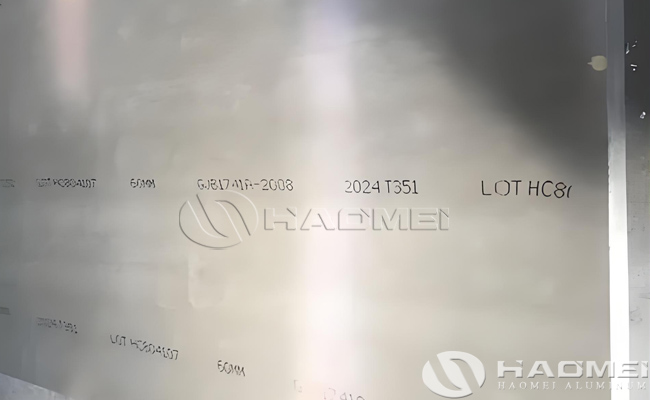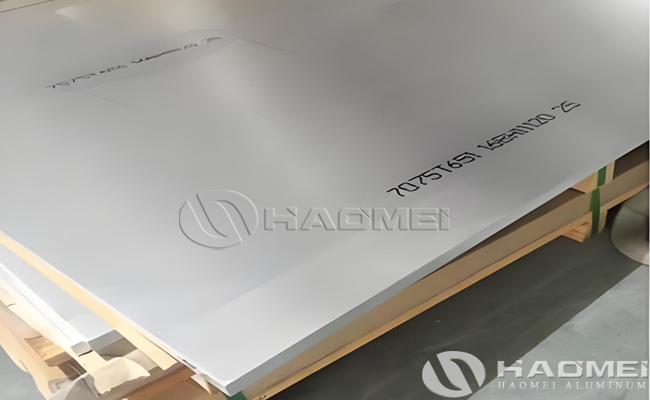Aluminium hard alloy plate is a sheet made of aluminum alloy as the base material and processed by special process, it has high strength and good corrosion resistance. This type of aluminum alloy plate mainly improves strength and hardness through heat treatment (quenching + aging). With high mechanical properties as the core feature, it is widely used in structural scenarios with high strength requirements. Hard aluminum alloy usually contains alloy elements such as copper, magnesium, zinc, and silicon. Common aluminum alloy series include 2000 series (aluminum-copper alloy), 6000 series (aluminum-magnesium-silicon alloy) and 7000 series (aluminum-zinc alloy).
- 2000series aluminum alloy (aluminum-copper alloy, core strengthening element is copper)
This is the most typical hard aluminum alloy. It achieves high strength by combining copper elements with heat treatment. It is a common material in the aerospace field.
Contains about 4% copper and 1.5% magnesium. It has high strength (tensile strength of about 470MPa) and excellent fatigue resistance, but poor corrosion resistance (surface treatment is required). Commonly used in aircraft skins, wing frames, and high-strength structural parts.
– 2A12 aluminum alloy:
Chinese brand (corresponding to 2024), with performance close to 2024, is a commonly used hard plate in the fields of domestic aviation, military industry, molds, etc.
– 2014 aluminum alloy:
Contains 4.4% copper, 0.8% silicon, and 0.5% magnesium. It has better heat resistance than 2024 aluminum and can maintain strength at higher temperatures. It is suitable for manufacturing engine parts and high-strength connectors.
- 7000series aluminum alloy (aluminum-zinc-magnesium-copper alloy, high-strength ace)
With zinc as the main strengthening element, combined with magnesium and copper, it is one of the highest strength series in the current industrial aluminum alloy, with hardness and strength far exceeding 2000 series.
Contains 5.1-6.1% zinc, 2.1-2.9% magnesium, and 1.2-2.0% copper. The tensile strength can reach more than 570MPa, with high hardness and good wear resistance, but poor weldability. It is widely used in aircraft landing gear, high-end sports equipment (such as bicycle racks), molds, and precision mechanical parts.
– 7A04 aluminum alloy:
Chinese brand (corresponding to 7075), the performance is consistent with 7075, it is the core material of domestic high-strength structural parts, and is often used in aerospace, high-pressure vessels and other scenes.
Based on 7075, it optimizes the stress corrosion resistance and is suitable for manufacturing large aviation structural parts (such as fuselage frames), with both high strength and stability.
Characteristics of aluminum hard alloy plate:
– High strength:
Hard aluminum alloy has high strength and is suitable for use in applications with large loads.
– Corrosion resistance:
After anodizing and other treatments, a protective film is formed on the surface, which can effectively resist corrosion.
– Lightweight:
Compared with steel, aluminum alloy has a lower density, which can reduce the weight of the overall structure.
– Good processability:
It can be processed through cutting, stamping, welding and other processes to meet different design requirements.
– Excellent thermal conductivity and electrical conductivity:
It is suitable for applications that require good thermal or electrical conductivity.
Application areas:
Aluminum hard alloy plates are widely used in aerospace, automobile manufacturing, architectural decoration, electronics and electrical, mechanical equipment and other fields. Specific applications include aircraft structural parts, automobile bodies, radiators, housings, brackets, etc.
The core of aluminium hard alloy plates are 2000 series (aluminum copper) and 7000 series (aluminum zinc magnesium copper). Among them, 2000 series focuses on fatigue resistance and medium strength, while 7000 series focuses on ultra-high strength. Both need to be heat treated to maximize performance. They are mainly used in aviation, military industry, high-end manufacturing and other fields with strict requirements on strength and hardness.


